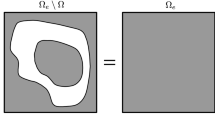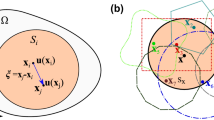Abstract
We present a strategy for the numerical integration of partial elements with the eXtended finite element method (X-FEM). The new strategy is specifically designed for problems with propagating cracks through a bulk material that exhibits inelasticity. Following a standard approach with the X-FEM, as the crack propagates new partial elements are created. We examine quadrature rules that have sufficient accuracy to calculate stiffness matrices regardless of the orientation of the crack with respect to the element. This permits the number of integration points within elements to remain constant as a crack propagates, and for state data to be easily transferred between successive discretizations. In order to maintain weights that are strictly positive, we propose an approach that blends moment-fitted weights with volume-fraction based weights. To demonstrate the efficacy of this simple approach, we present results from numerical tests and examples with both elastic and plastic material response.


















Similar content being viewed by others
References
Moes N, Dolbow J, Belytschko T (1999) A finite element method for crack growth without remeshing. Int J Numer Methods Eng 46:131–150
Melenk JM, Babuška I (1996) The partition of unity finite element method: basic theory and applications. Comput Methods Appl Mech Eng 139:289–314
Belytschko T, Black T (1999) Elastic crack growth in finite elements with minimal remeshing. Int J Numer Methods Eng 45:601–620
Sukumar N, Dolbow JE, Moes N (2015) Extended finite element method in computational fracture mechanics: a retrospective examination. Int J Fract 196:189–206
Ventura G (2006) On the elimination of quadrature subcells for discontinuous functions in the extended finite-element method. Int J Numer Methods Eng 66:761–795
Natarajan S, Mahapatra DR, Bordas SPA (2010) Integrating strong and weak discontinuities without integration subcells and example applications in an XFEM/GFEM framework. Int J Numer Methods Eng 83:269–294
Chin EB, Lasserre JB, Sukumar N (2016) Modeling crack discontinuities without element-partitioning in the extended finite element method. Int J Numer Methods Eng 110:1021
Sudhakar Y, Wall WA (2013) Quadrature schemes for arbitrary convex/concave volumes and integration of weak form in enriched partition of unity methods. Comput Methods Appl Mech Eng 258:39–54
Elguedj T, Gravouil A, Combescure A (2006) On the elimination of quadrature subcells for discontinuous functions in the extended finite-element method. Comput Methods Appl Mech Eng 195:501–515
Liu X, Waisman H, Fish J (2012) A new crack tip enrichment function in the extended finite element method for general inelastic materials. J Multiscale Comput Eng 10:343–360
Martin A, Esnault JB, Massin P (2015) About the use of standard integration schemes for X-FEM in solid mechanics plasticity. Comput Methods Appl Mech Eng 283:551–572
Rashid MM (1993) Incremental kinematics for finite element applications. Int J Numer Methods Eng 36:3937–3956
Simo JC, Hughes TJR (1998) Computational inelasticity. Springer, New York
Richardson CL, Hegemann J, Sifakis E, Hellrung J, Teran JM (2011) An X-FEM method for modeling geometrically elaborate crack propagation in brittle materials. Int J Numer Methods Eng 88:1042–1065
Lyness JN, Jespersen D (1975) Moderate degree symmetric quadrature rules for the triangle. J Inst Math Appl 15:19–32
Song JH, Areias PMA, Belytschko T (2006) A method for dynamic crack and shear band propagation with phantom nodes. Int J Numer Methods Eng 67:868–893
Wissmann JW, Becker T (1986) Partially symmetric cubature formulas for even degrees of exactness. SIAM J Numer Anal 23(3):676–685
Hughes TJR (1980) Generalization of selective integration procedures to anisotropic and nonlinear media. Int J Numer Methods Eng 15(9):1413–1418
Moran B, Ortiz M, Shih CF (1990) Formulation of implicit finite element methods for multiplicative finite deformation plasticity. Int J Numer Methods Eng 29(3):483–514
Mathworks I (2015b) MATLAB and statistics toolbox release 2014a. The MathWorks Inc., Natick
Gaston D, Newman C, Hansen G, Lebrun-Grandié D (2009) A parallel computational framework for coupled systems of nonlinear equations. Nucl Eng Des 239(10):1768–1778
Moumnassi M, Belouettar J, Bechet E, Bordas S, Quoirin D, Potier-Ferry M (2011) Finite element analysis on implicitly defined domains: an accurate representation based on arbitrary parametric surfaces. Comput Methods Appl Mech Eng 200(5–8):774–796
Acknowledgements
The bulk of the work presented in this manuscript was performed while first author Ziyu Zhang was a graduate research assistant in the Duke Computational Mechanics Laboratory. The support of Duke University is gratefully acknowledged. All authors would also like to acknowledge the support of the Idaho National Laboratory’s Laboratory Directed Research and Development (LDRD) program (Project 13-071) and the Consortium for Advanced Simulation of Light Water Reactors (CASL), an Energy Innovation Hub under the U.S. Department of Energy. This manuscript has been authored by Battelle Energy Alliance, LLC under Contract No. DE-AC07-05ID14517 with the U.S. Department of Energy. The United States Government retains and the publisher, by accepting the article for publication, acknowledges that the United States Government retains a nonexclusive, paid-up, irrevocable, world-wide license to publish or reproduce the published form of this manuscript, or allow others to do so, for United States Government purposes.
Author information
Authors and Affiliations
Corresponding author
Rights and permissions
About this article
Cite this article
Zhang, Z., Jiang, W., Dolbow, J.E. et al. A modified moment-fitted integration scheme for X-FEM applications with history-dependent material data. Comput Mech 62, 233–252 (2018). https://doi.org/10.1007/s00466-018-1544-2
Received:
Accepted:
Published:
Issue Date:
DOI: https://doi.org/10.1007/s00466-018-1544-2




